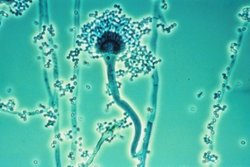Aspergillus fumigatus
| Aspergillus fumigatus | |
|---|---|
 |
|
| Aspergillus fumigatus | |
| Scientific classification | |
| Kingdom: | Fungi |
| Phylum: | Ascomycota |
| Class: | Eurotiomycetes |
| Order: | Eurotiales |
| Family: | Trichocomaceae |
| Genus: | Aspergillus |
| Species: | fumigatus |
| Binomial name | |
|
Aspergillus fumigatus Fresenius 1863 |
|
| Synonyms | |
|
Neosartorya fumigata |
|
Neosartorya fumigata
O'Gorman, Fuller & Dyer 2008
Aspergillus fumigatus is a fungus of the genus Aspergillus, and is one of the most common Aspergillus species to cause disease in individuals with an immunodeficiency.
A. fumigatus, a saprotroph widespread in nature, is typically found in soil and decaying organic matter, such as compost heaps, where it plays an essential role in carbon and nitrogen recycling. Colonies of the fungus produce from conidiophores thousands of minute grey-green conidia (2–3 μm) that readily become airborne. For many years, A. fumigatus was thought to only reproduce asexually, as neither mating nor meiosis had ever been observed. In 2008, however, A. fumigatus was shown to possess a fully functional sexual reproductive cycle, 145 years after its original description by Fresenius. Although A. fumigatus occurs in areas with widely different climates and environments, it displays low genetic variation and lack of population genetic differentiation on a global scale. Thus the capability for sex is maintained even though little genetic variation is produced.
The fungus is capable of growth at 37 °C or 99 °F (normal human body temperature), and can grow at temperatures up to 50 °C or 122 °F, with conidia surviving at 70 °C or 158 °F—conditions it regularly encounters in self-heating compost heaps. Its spores are ubiquitous in the atmosphere, and it is estimated that everybody inhales several hundred spores each day; typically these are quickly eliminated by the immune system in healthy individuals. In immunocompromised individuals, such as organ transplant recipients and people with AIDS or leukemia, the fungus is more likely to become pathogenic, over-running the host's weakened defenses and causing a range of diseases generally termed aspergillosis. Several virulence factors have been postulated to explain this opportunistic behaviour.
...
Wikipedia
